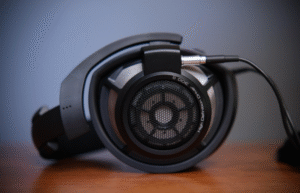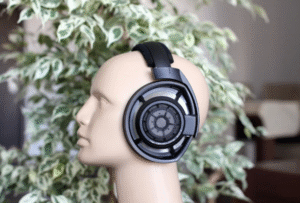The Sennheiser HD 800 S delivers exceptional audio fidelity. It delivers consistent sound not only when worn, but also with glasses or long hair, ensuring you hear virtually the same sound every time.
The balanced tuning aligns with our goal of rich, clear sound, but, as an open-back headphone, it doesn’t emphasize the deep bass.
The drivers are well-matched for a balanced stereo soundstage, and the group delay ensures a tight and transparent response.
Furthermore, the design blends seamlessly with the ear canal, much like an angled reference speaker. Low harmonic distortion ensures a clean sound.
Sennheiser HD 800S Review: Over-Ear Audiophile Headphone

Design
The Sennheiser HD 800S are premium audiophile headphones, and their design reflects this. The frame is crafted from a combination of high-quality plastic and metal, creating a striking visual contrast.
The open-enclosure construction features wide earcups with metal grilles that protect the drivers from damage.
These over-ear headphones offer a comfortable fit thanks to their large, wide earcups and luxurious suede padding.
While not a tight fit, they are somewhat heavy, but you won’t experience significant fatigue even after prolonged use.
Build

The HD 800S is one of the most unique and recognizable headphones on the market. This is due in part to their legendary reputation, but also to their beautiful, distinctive design.
Built with a completely open design and a blend of high-quality materials, the heart of these headphones is a 56mm ring radiator transducer.
This not only contributes to the headphones’ structural rigidity but also enhances audio fidelity (more on this later).
The headphone chassis is constructed from vibration-damping materials and features an inert headband insert, providing exceptional stability and eliminating unwanted resonance.
Even the steel mesh baffle is meticulously tailored for consistency, enhancing the overall precision of the sound.
Sound Impressions

The HD800 is known as a reference-tuned headphone. I agree with this conclusion.
Everything is consistent, with virtually no peaks or leakage. But as always, let’s take a closer look at the frequency response, starting with the lows.
Bass
The HD800S’s bass is subtle yet incredibly detailed. While not particularly rich, it’s sufficiently high quality. Every beat and transient is fast and precise.
Furthermore, the mid-bass is consistent and well-defined. Personally, I prefer headphones with a bit more dimensionality, especially in the mid-bass.
However, that would make these headphones sound warm, which is not their goal. Rather, they are completely linear.
What I find most unique about the bass of these headphones is how well they convey impact and dynamics despite their limited lows.
Every kick drum strike is witty, and every note is precise. But what’s most impressive is that all of this is achieved without compromising the sound in any way.
Midrange

The midrange of these headphones is clean and clear. Vocals are crisp and present without being overpowering. Instrument separation is excellent, providing excellent layering.
Details are rich, and midrange instruments have character. And again, all of this is achieved without compromising the sound.
I was particularly impressed by the ample space in the midrange.
When listening to classical music like Tchaikovsky’s Symphony No. 5, I could vividly sense the spaciousness. Instruments had room to resonate and shine.
Treble

The treble of the headphones is the biggest improvement over the previous generation. The 800S’s treble perfectly matches the rest of the frequency response, delivering ample headroom and a rich sparkle.
Detail reproduction is astonishing, and the ability to express these details is top-notch.
The soundstage is as dynamic as the rest of the headphones, and the texture of hi-hats and other high-frequency instruments further enhances the headphones’ subtle sheen.
Conclusion
The Sennheiser HD800S offers a truly unique headphone experience. They remain the industry standard in terms of neutrality, technical performance, and soundstage.

While careful amplifier matching can be beneficial, achieving good results doesn’t have to be expensive.
With the increasing use of EQ, tuning to personal taste has become easier than ever. Last but not least, they remain among the most comfortable headphones on the market.
